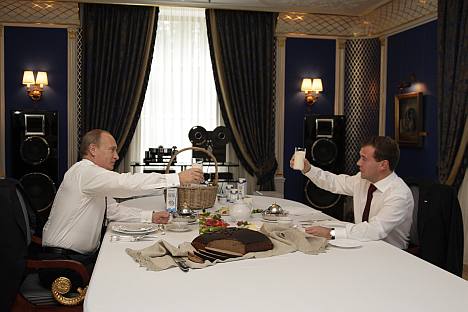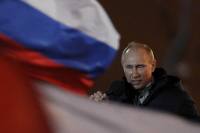Back to the Kremlin

President Medvedev, right, and President-elect Putin enjoy a glass of milk at the former’s official residence. Source: ITAR-TASS
On May 7, Vladimir Putin will once again
become president of Russia
after an hour-long inauguration ceremony. After having previously served two
consecutive four-year terms of office, this time he will be installed for six
years.
In spite of its rich history, modern Russia is still
a young state. In the 20 years since its new political biography began, new
political traditions have evolved.
Putin’s first inauguration ceremony was held on May 7, 2000, and subsequent inaugurations – his again in 2004 and Dmitry Medvedev’s in 2008 – have followed on the same date. Every president is given a fixed term under the constitution: even if the presidential election had gone to a second round, the inauguration ceremony for Russia’s head of state would still have taken place on May 7.
That date will remain unchanged in 2018, unless Putin leaves office before
his term expires – as did Russia’s
first president, Boris Yeltsin. In such a case, the inauguration clock hands
would be moved and a new count started – in the hope that such an upheaval
would not recur in the future.
The American word “inauguration”, which came to Russia
under Boris Yeltsin, took some time to take root in Russia. It is a foreign-sounding
word that was at first difficult to pronounce for Russians. So, when
journalists covered the event in 1996, they preferred to say that Boris Yeltsin
was assuming office and not that he was being inaugurated. They were afraid to
get it wrong. Now, though, the term has become part of the Russian language and
of Kremlin protocol.
Family matters
Unlike in the United States, the president’s
spouse does not stand next to the president during the ceremony, but looks on
from the side; she is essentially surrendering him to the civil service. This
is also the case for both speakers of the two houses of parliament and the Constitutional Court
chairman. The First Lady’s husband becomes the head of state – and family
automatically recedes into the background.
The nearly 2,000 guests at the ceremony
– who include MPs, government ministers, presidential administrators,
governors, cultural figures, political scientists, media representatives and
diplomats – often feel a sneaking sense of sympathy for the person who is about
to take the oath, because it can be rather lonely at the top.
The seating arrangements of the guests depend on their social and political
status, with those lower down the hierarchy watching the events from a screen.
The ceremony takes place in and around three Kremlin halls. The would-be
president starts his path to the pinnacle of power by walking along the red carpet amid the
breathtaking grandeur of the Grand
Kremlin Palace.
First, he walks through the magnificent St George Hall. Commemorating Russian
military glory, the St George Hall has seen emperors, heroes of the 1812 war,
leaders of the Soviet Union and
participants in the 1945
Victory Parade. It is still
the place where government decorations and state prizes are awarded.
Several minutes later, the future president enters the St Alexander Hall, named
in honour of the Order of St Alexander Nevsky founded in 1725 by Catherine the
Great. After losing its magnificent interiors in the Thirties, when it was
refurbished to house sessions of the Supreme Soviet of the USSR, this hall
was restored to its former glory in the Nineties.
The next destination is the St Andrew Hall, the former throne room and main
imperial hall in the Kremlin, where he is met by the head of the Constitutional Court,
the master of ceremonies. From there, the main action begins.
In the short history of the inauguration ceremony, there has not been a single
president of Russia
who has not felt nervous covering that path. The inauguration of Dmitry
Medvedev in 2008 was the first time the ceremony was attended by a former
president – in this case Mr Putin – and his presence provided moral support for
the new head of state.
Before that, both Boris Yeltsin and Vladimir Putin handed over power to themselves
– either because they were elected for a second term or because they didn’t
assume power from anyone else. Boris Yeltsin became Russia’s first president in 1991,
and in 2000 Putin simply had the word “acting” removed from his title of
acting president, after the resignation of Mr Yeltsin.
It now looks as if the presence of the former president,
who will even deliver a short speech, is likely to
become a new tradition.
The actual inauguration takes place
fairly quickly. The symbols of presidential power – the standard, the
president’s official badge and a special copy of the constitution usually kept
in the presidential library between inaugurations – await the future head of
state. He recites a brief oath, vowing to serve his country, with his hand on
the volume of the constitution and not the Bible, as is the case in some
countries.
Within minutes, the country acquires a new head of state, who makes a short
speech immediately after being sworn in. This is a set tradition. As a rule,
the inaugural address reiterates what the president promised during his
electoral campaign. When Vladimir Putin famously said: “The president in Russia is more
than a president” in his first inauguration speech, it had a particularly
symbolic ring in the St Andrew Hall, the former throne room.
When all the speeches have been made, the president makes the same journey back
through the Kremlin’s three halls. A brief parade of the presidential regiment
takes place while the new president prepares for the evening reception, where
there are usually 1,000-1,200 guests.
With rare exceptions, heads of foreign states are invited neither to the
ceremony nor the reception, as this is considered to be an internal Russian
matter. Incidentally, history was made at the 2008 reception, when the
presidential band performed Smoke on the Water specially for President Dmitry
Medvedev, who is an ardent Deep Purple fan. Nothing like it had ever been heard
at such events before.
Thereafter, the president moves into his new office, which is located in the
former Kremlin Senate, a building commissioned by Catherine the Great and
constructed from 1776-1787. (In his time, Lenin chose to have his office in
Kremlin Building One and Stalin
followed suit.) This seat
of power has a fairly
ascetic look, a tradition
inherited from the Soviet leaders: wood-panelled
walls, bookshelves, a huge table at which conferences are held and the
president’s writing desk.
The presidential staff are located near their boss, as they refer to him behind
his back. But their exact location depends on their post. Those who are very
close to the president, including important aides and advisers and the
presidential guards, sit in Building 14, connected to Building One by an
underpass. However, Building 14 is currently under repair, so all the
presidential advisors have moved to Staraya Ploshchad, the former headquarters
of the Central Committee of the Communist Party, where lower-ranking members of
the administration have their offices.
Contrary to a popular
misconception
(which owes its existence either to analogy with the White House in the US or to the Stalin era
when the party elite lived inside the Kremlin), the present Russian leaders
only work in the Kremlin, and live several miles outside the Moscow city centre
in the most prestigious neighbourhood.
Each of the three Russian presidents – Yeltsin, Putin and Medvedev – received
their own residence. These properties, which are on the state balance sheet,
need not be vacated after the expiry of a presidential term. This will save Mr
Medvedev the undignified rush to move home that the outgoing British prime ministers
have to face as they bundle their belongings out of 10 Downing Street – before their
successor smugly usurps their living quarters.
Since Yeltsin’s death, his widow, Naina, has lived at the residence they
were given when he was head of state. Likewise, when Dmitry Medvedev became
president in 2008, Mr Putin stayed in his former mansion surrounded by pine
trees at Novo-Ogaryovo; Mr Medvedev lives nearby in Gorky. These properties are not just
residential houses but complexes equipped for work; they even have guest
houses. The president spends a considerable part of his time working at home
rather than in the Kremlin, and it is to this location that the new Russian
president will repair on May 7, after his inauguration.
Along with all the presidential paraphernalia, which includes the standard, Air Force One and the nuclear suitcase, Putin will receive two more things: the presidential ID, which he is unlikely to ever have to use because there is not a single person in the country who does not know his face; and colossal responsibility for the important decisions he will have to take over his next six years in power.
All rights reserved by Rossiyskaya Gazeta.
Subscribe
to our newsletter!
Get the week's best stories straight to your inbox
